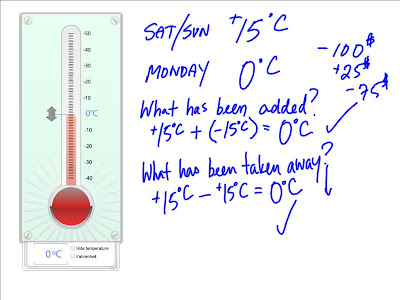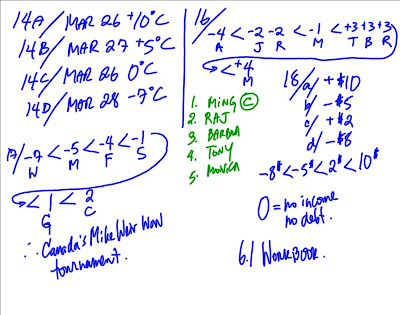Science
3.4 Mini Lab 2 pg.64-66
Separating
Environmental Mixture of Oil & Water
Purpose:
In this experiment I will investigate different methods
of removing oil from water.
Hypothesis:
If I use cotton balls to soak up the oil, then I think…
If I use a medicine dropper to suck up the oil, then I
think…
If I use a straw to move the oil to one corner, then I
think…
If I use drops of detergent to the oil, then I think…
Observations:
Treatment
|
Results
|
Separating
using cotton balls
|
|
Separating
using medicine dropper
|
|
Separating
using straw
|
|
Separating
using detergent
|
Analysis:
A & B text pg.66
Conclusion:
What did you learn about separating oil from water?
What environmental impact would an oil spill in the ocean have?
How accurate was your hypothesis?
I will bring in all the necessary materials for the above mini lab
6.2 integer experiment: adding positive and negative integers text pg.190-191
Toss #
|
Result
H or T
|
Point Value
H= +1
T= -1
|
Total Score
|
1
|
|||
2
|
|||
3
|
|||
4
|
|||
5
|
|||
6
|
|||
7
|
|||
8
|
|||
9
|
|||
10
|
|||
11
|
|||
12
|
|||
13
|
|||
14
|
|||
15
|
|||
16
|
|||
17
|
|||
18
|
|||
19
|
|||
20
|
Paul’s first 5 tosses were (-1) + (-1) + 1 + 1 + 1 with
a total score of 1 since the dotted line on his graph begins at (-1) and ends at +1
after 5 tosses.
My first 5 tosses were ________________________ with a
total score of _____ since the dotted line on my graph begins at ____ and ends
at ____ after 5 tosses.
After 20 tosses, Paul’s final score is ______.
After 20 tosses, my final score is _______.
Our results are similar because…
Our results are different because…
I noticed that when the value of the toss is +1 the
total score…
I noticed that when the value of the toss was -1 the
total score…
If I repeated the experiment with 50 coin tosses then I
think the greatest possible total score would be…
If I repeated the experiment with 50 coin tosses then I
think the least possible total score would be…




